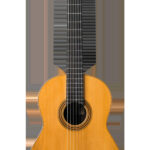Shielding the tremolo cavity of your guitar is a common practice for reducing unwanted noise and interference, leading to a cleaner and quieter signal. However, guitarists sometimes encounter an annoying problem after shielding: the guitar jack shorts out when a cable is plugged in. This issue typically arises because adding shielding reduces the space within the cavity, particularly around the output jack. Let’s explore why this happens and, more importantly, how to fix it properly.
The Problem: Shorting Jacks After Shielding
When you line the tremolo cavity with shielding material, you’re essentially adding a layer of conductive material to the walls. This is great for blocking electromagnetic interference, but it can also decrease the internal space of the cavity. The problem manifests when inserting your guitar cable; the tip of the cable jack makes contact with the shielding material at the back of the cavity, causing a short circuit. This is more noticeable after shielding because the conductive material creates a potential ground contact point where there wasn’t one as readily before.
Some might suggest the quick fix is to simply remove the shielding from the jack cavity altogether.
The Wrong Solution: Unshielding the Cavity
While removing the shielding might solve the immediate shorting issue, it defeats the purpose of shielding in the first place. Unshielding a cavity to avoid a short is a compromise that reintroduces the noise and interference you were trying to eliminate. It’s akin to treating the symptom and ignoring the root cause. Manufacturers sometimes suggest this as a simple workaround, but it’s not the ideal solution for players serious about reducing noise.
The Right Solution: Expanding the Tremolo Cavity
The correct approach is to create more space within the tremolo cavity so the jack prong can extend fully without touching the shielding. The most effective way to do this is by carefully removing a small amount of wood from the back wall of the cavity.
Attempting to drill out wood with a standard drill bit can be risky. A slip could lead to damage beyond the cavity itself, potentially marring the guitar’s finish or structure.
A safer and more controlled method is to use a router, specifically with a dovetail bit.
Using a Dovetail Router Bit
A dovetail router bit is designed to undercut wood, meaning it removes material beneath the surface. This is perfect for our situation because it allows you to deepen the cavity without widening the opening on the guitar’s top surface. By using a router with a dovetail bit, you can precisely remove a small amount of wood from the back of the cavity, creating the necessary clearance for the jack. This method minimizes the risk of damaging the guitar and provides a clean, professional result.
This technique provides a safe way to expand the cavity, ensuring the jack doesn’t short against the shielding while maintaining the cavity’s shielding effectiveness.
When is Tremolo Cavity Shielding Necessary?
While shielding the tremolo cavity, including the jack area, can be beneficial, it’s worth noting that the jack cavity itself might not always be the primary source of noise. Often, shielding the control cavity is sufficient to significantly reduce guitar noise. However, for players seeking maximum noise reduction, especially in high-gain situations or electrically noisy environments, shielding the tremolo cavity including the jack area can offer an extra layer of noise protection. If you aim for thorough shielding, addressing potential jack shorting is a crucial step.
Conclusion
Encountering a shorting jack after shielding your guitar’s tremolo cavity is a common but easily resolvable issue. Instead of compromising your shielding efforts by unshielding the jack cavity, the proper solution is to carefully expand the cavity, ideally using a router with a dovetail bit. This ensures your guitar remains shielded for optimal noise reduction while eliminating the frustrating shorting problem, keeping your signal clean and your playing experience enjoyable.

